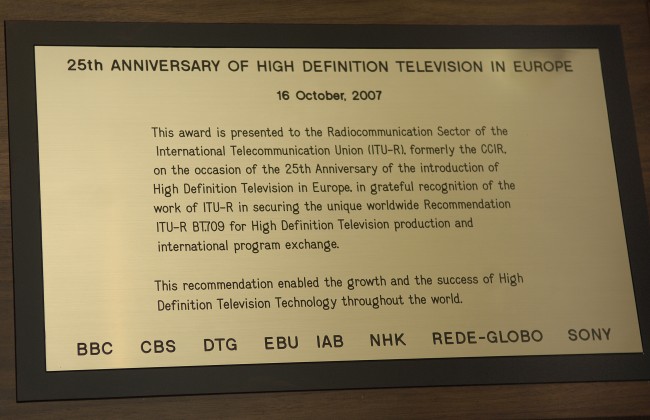High Definition Television (HDTV) is the most powerful and influential media in human experience. HDTV brings
sharper pictures to television audiences, and provides a stunning viewing experience on today�s large screen
HDTV television sets. It will shape the way we experience and see the world.
HDTV is now replacing conventional television as all media channels make the transition to HDTV. Eventually all
the world�s television viewers, current 4.5 billion, will be watching HDTV, thanks to the work of the ITU.
The idea of HDTV came from Japan, and from the fundamental work of the research laboratories of Japan�s
national broadcaster, NHK.
2006 and 2007 marked the 25th anniversaries of the first demonstrations of HDTV, respectively in North America
and in Europe.
Since 1972, the former CCIR Study Group 11 began to focus its activities on High-Definition Television
recommending some of the characteristics of the first analogue systems, which, incidentally, produced base-band
signals which could not fit in any of the broadcasting bands available at that time.
Only after the introduction of digital techniques and over twenty years of continuous studies, in 1998, it was
possible to unanimously approve Recommendation ITU-R BT.709 in its current version. It represents what is
recognized today as an outstanding achievement of the ITU: the specifications for a single worldwide standard
for HDTV production and program exchange, based on an image sampling structure of 1920x1080 pixels in what
has become known as the Common Image Format (CIF). The approval of Recommendation ITU-R BT.709 triggered a high level of activity on the part of manufacturers
and broadcasters to develop the tools and the know-how to implement extensive HDTV program production.
Since then Recommendation ITU-R BT.709 has remained unchanged, thus allowing manufacturers to produce
equipment at an ever-lower cost. Not surprisingly such equipment today costs even less than any other comparable
equipment for television systems of inferior quality, thus demonstrating the benefits offered by international
broadcasting standards, and the success of the ITU in its role as an international standard-setting body. Dr Timofeev, Director of the ITU-R, states "The world owes the pioneers and all those who worked in the ITU
on HDTV a great debt of gratitude. We can only hope to emulate their success in the coming age of Super High
Definition Television, and for future technologies of the media". More...
Honorary plaque presented by BBC, CBS, NHK, EBU, IAB, DTV, Rebe Globo and Sony to the Radiocommunications Sector of the International Telecommunication Union, ITU-R, (formerly CCIR), on the occasion of the 25th Anniversary of the introduction of High-Definition Television in Europe
 Source: ITU / J.M. Ferr� (Compulsory) Source: ITU / J.M. Ferr� (Compulsory)
Speeches- Remarks delivered by Mr Joseph A. Flaherty, Senior Vice President, Technology, CBS Broadcasting Inc. English only
- Remarks by ITU Secretary-General at Opening of the 25th Anniversary Celebration of the introduction of HDTV in Europe English only
- Remarks by Director, BR, at the opening of the 25th anniversary celebrations of the introduction of HDTV in Europe English only
- BBC (British Broadcasting Corporation) remarks (by Andy Quested, Principal Technologies, Future Media & Techology, BBC) English only
- NHK (Japan Broadcasting Corporation) remarks (by Mr Yukihiro NISHIDA, Senior Research Engineer, NHK) English only
- EBU (European Broadcasting Union) remarks (by Lieven Vermaele, Director, Technical Department, EBU) English only
- ITU-R studies of the HDTV standards resulted in the HDTV growth worldwide (by Prof. Mark Krivocheev, Honorary Chairman of the ITU-R Study Group 6 and Former Chairman of ITU-R (CCIR) SG 11) English only
Useful link |



